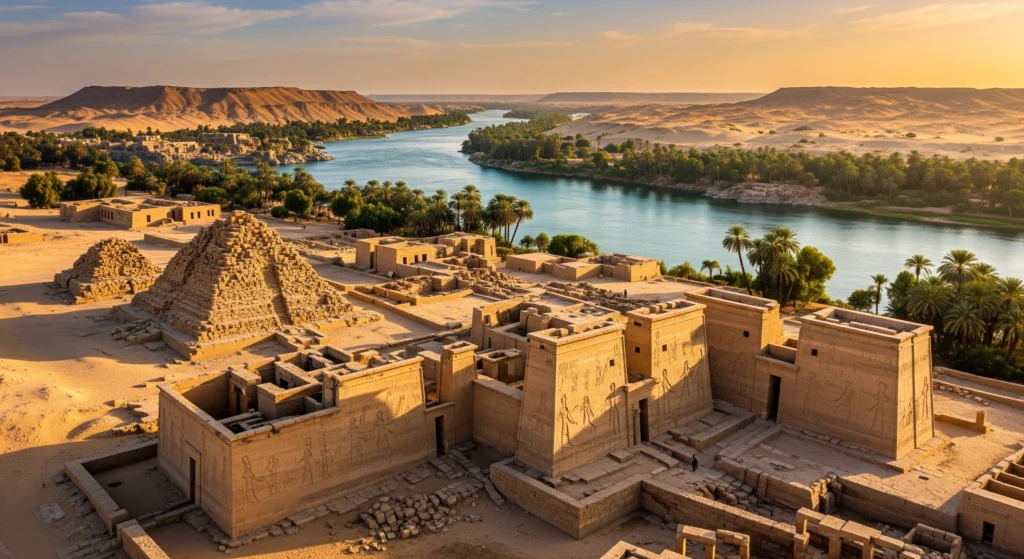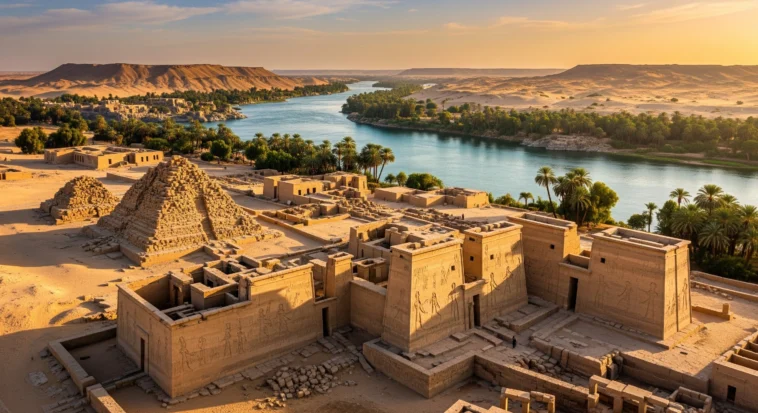
Deep along the Nile in modern Sudan and southern Egypt, the ancient Nubian kingdoms were powerhouse civilizations — think towering pyramids, clever irrigation, and pharaohs who ran advanced societies that rivaled Egypt.
Recent digs show they thrived for over three millennia and were far more complex and tech-savvy than people realized.
Imagine archaeologists like treasure hunters pulling whole chapters of history out of the sand — that’s Nubia being rediscovered.
Trust me, these guys deserve way more spotlight.
The Geographic Foundation of Nubian Power
Nubia sat like a powerhouse at the Nile’s crossroads — from the first cataract in Upper Egypt, east to the Red Sea, down to around modern Khartoum, and out to the Libyan Desert.
That spot wasn’t random: it made Nubia the middleman of ancient trade, linking sub-Saharan Africa with Egypt and the Mediterranean.
Think of it as the Amazon warehouse of the ancient world — gold, copper, iron, ebony, ivory, incense — all flowing through here and turning Nubia into serious wealth.
Those Nile cataracts? They acted like natural speed bumps and fortresses at the same time, giving Nubian kingdoms defensible positions so they could stay independent for ages.
Around 5000 BC, people from the Sahara moved toward the Nile and brought pottery with them — a small everyday skill that kickstarted a continuous cultural growth.
Little moves like that built, over millennia, some of Africa’s most impressive ancient civilizations.
The Kingdom of Kerma: Nubia’s First Great Power
Kerma was Nubia’s first major kingdom, popping up around 2500 BCE and hitting its stride around 1785 BCE just as Egypt’s Middle Kingdom was losing steam.
Basically, while Egypt was stumbling, Nubia was stepping into the spotlight.
Archaeologists digging Kerma have uncovered one of Africa’s most jaw-dropping ancient cities.
We’re talking thousands of graves, sprawling residential areas, and the famous Deffufa temples — massive mud-brick structures some over 18 meters tall!
The Western Deffufa was all about religion, while the Eastern one was probably a fortress.
Spiritual center by day, military stronghold by night — Kerma knew how to multitask.
What really makes Kerma awesome is its unique African identity.
Unlike the Egyptians, Nubians built round huts, oval temples, and curved-wall bastions.
It wasn’t copying anyone; they were crafting their own style while still rubbing elbows with neighbors.
Think of it like an indie artist making hits that even the big labels notice — Kerma was doing its own thing and crushing it.
The Rise of the Kingdom of Kush: Black Pharaohs of Egypt
Few chapters of Nubian history are as epic as the era of the “Black Pharaohs” — Kushite rulers who actually conquered and ruled Egypt during the 25th Dynasty (around 744–656 BCE).
The Kingdom of Kush, first at Napata and later Meroë, was the peak of Nubian power and culture.
The star of the show was Piye. Around 744 BCE, he marched into Egypt and basically said, “This is ours now.”
Fast-forward to 2003, when archaeologist Charles Bonnet uncovered seven massive black granite statues at Kerma — each over two meters tall!
Some show Piye’s son Taharqa and his successor Tantamani, proving that even centuries later, Kerma was still a big deal.
The Black Pharaohs ruled Egypt for nearly 100 years, building impressive temples, reforming religion, and showing themselves as the true heirs of the pharaohs.
Taharqa, maybe the MVP of them all, oversaw a golden era of construction and prosperity across both Egypt and Nubia.
Imagine being a Nubian king and suddenly running Egypt — that’s some next-level history.
Meroë: The Last Great Nubian Kingdom
After the Kushite kings got kicked out of Egypt by the Assyrians, they moved south to Meroë, near today’s Khartoum.
By 300 BC, Meroë was the new heart of Nubian power, with rulers buried in fertile grasslands and the kingdom buzzing with trade all the way to the Mediterranean.
Meroë wasn’t just surviving — it was thriving, and here’s why:
Iron Production and Technology
Meroë was a hub for pyramids and iron!
These guys were some of Africa’s first iron producers, and you can still see huge slag heaps today.
Imagine walking past giant piles of ancient metal scraps — that’s evidence of a serious industrial empire.
Agricultural Innovation
To water their crops efficiently, the Meroites built a water wheel called the saqiyah (or kolē).
It could lift water 3–8 meters with way less effort than older methods, basically like inventing a medieval “irrigation cheat code.”
Written Language
The Meroites even created their own script, Meroitic.
It’s still undeciphered today, like a secret code from the past.
Some think it was also used to write Old Nubian, but no one’s cracked it fully yet — imagine having a diary that no one in the world can read!
Archaeological Revelations and Modern Discoveries
Modern archaeology is turning what we thought we knew about Nubia completely upside down.
For example, archaeologists from the University of Geneva recently dug up a pit full of giant monuments and finely carved statues of the Nubian kings — the “Black Pharaohs.”
The Swiss lead archaeologist even told the BBC it was a discovery of global importance.
These finds are huge because they smash old ideas that ancient African civilizations were somehow “less advanced.” The truth? Nubia was sophisticated, powerful, and full of surprises.
You can find sites like this all along the Nile in northern Sudan, each loaded with artifacts, decorated tombs, temples, and entire ancient towns.
Every object tells a story about who the Nubians really were.
The catch? Many of these sites are under threat from modern construction, climate change, and political instability.
Archaeologists are racing against time — it’s like a real-life Indiana Jones adventure, except the treasures are history itself.
Cultural Achievements and Artistic Legacy
The Nubians were serious artists — their work can go toe-to-toe with any ancient civilization.
They crafted stunning jewelry, pottery, sculptures, and metalwork that show off both insane skill and a great eye for beauty.
What’s super cool is how Nubian art mixes influences while staying totally unique.
Sure, you’ll see some Egyptian-style motifs, but Nubian artists didn’t just copy — they transformed them into something completely their own.
The famous “Kushite style” of sculpture, for example, shows African features in a natural, realistic way — one of the earliest times Africa saw itself truly represented in ancient art.
Religion was just as creative. Nubians blended their local traditions with Egyptian and other influences.
Amun, a major Egyptian god, became especially important during the Kushite period, and the temple at Jebel Barkal was considered the god’s original home — basically their own holy headquarters.
The Christian Kingdoms: Nubia’s Final Chapter
After the fall of Kush in the 4th century AD, Nubia entered its last great chapter with the rise of three Christian kingdoms: Nobatia, Makuria, and Alodia.
Makuria and Alodia lasted nearly a thousand years — that’s seriously impressive for any kingdom!
In the 6th century, Christianity swept through the region, flipping society upside down.
Ancient temples gave way to churches, and Christian art started popping up everywhere.
These kingdoms held their ground for centuries, resisting Islamic expansion longer than most Christian territories nearby — talk about staying power!
Archaeologists have uncovered amazing evidence from this era, like a Christogram tattoo on a 1,300-year-old body.
Imagine that — someone from over a millennium ago proudly marking their faith on their skin.
These finds give us a personal, almost human glimpse into the lives of Christian Nubians.
Economic Foundations and Trade Networks
Nubia got rich the smart way — location and resources.
Sitting at the crossroads of major trade routes and sitting on piles of gold, Nubian kingdoms became powerhouses.
Their gold was so prized that ancient Egyptians and Mediterranean traders were practically lining up for it.
But Nubia didn’t stop at Egypt.
Archaeologists have found evidence they traded with the Roman Empire, Byzantine lands, and even far-off parts of Africa and Asia.
Their markets were full of luxury goodies: Chinese silk, Indian spices, and gemstones from all over Africa — basically the ancient version of a global Amazon.
Nubians weren’t just hoarding treasure; they had sophisticated trade systems.
Standardized weights and measures, metal bars as currency, and later coins made long-distance trade smooth and reliable.
It’s like they invented the blueprint for international commerce centuries before anyone else.
Legacy and Modern Significance
The ancient Nubian kingdoms left a mark on history that’s only now getting the attention it deserves.
Scholars are finally realizing just how important Nubia was in ancient politics, trade, and cultural exchange.
Studying Nubia teaches us a lot about how African states formed, how technology advanced, and how cultures stayed strong even under pressure.
These kingdoms were masters of holding their ground while interacting with powerful neighbors — basically ancient diplomacy at its finest.
Today, Nubia’s archaeological treasures are under threat.
Political instability in Sudan makes research tricky, modern dams could drown historic sites, and climate change plus urban growth put more pressure on these irreplaceable places.
It’s like racing to save a giant library of secrets before it disappears forever — and the clock is ticking.
Conclusion: Reclaiming Africa’s Ancient Heritage
The Nubian kingdoms were amazing — and way more advanced than most people realize.
From Kerma’s bustling city life to Meroë’s iron production, and the Black Pharaohs ruling Egypt, Nubia shows that African civilizations were powerful, innovative, and creative.
Archaeologists keep uncovering new treasures — tombs, artifacts, inscriptions — each one revealing more about these incredible societies.
Nubia challenges old stereotypes about ancient Africa and proves the continent was a hub of wealth, technology, and culture.



